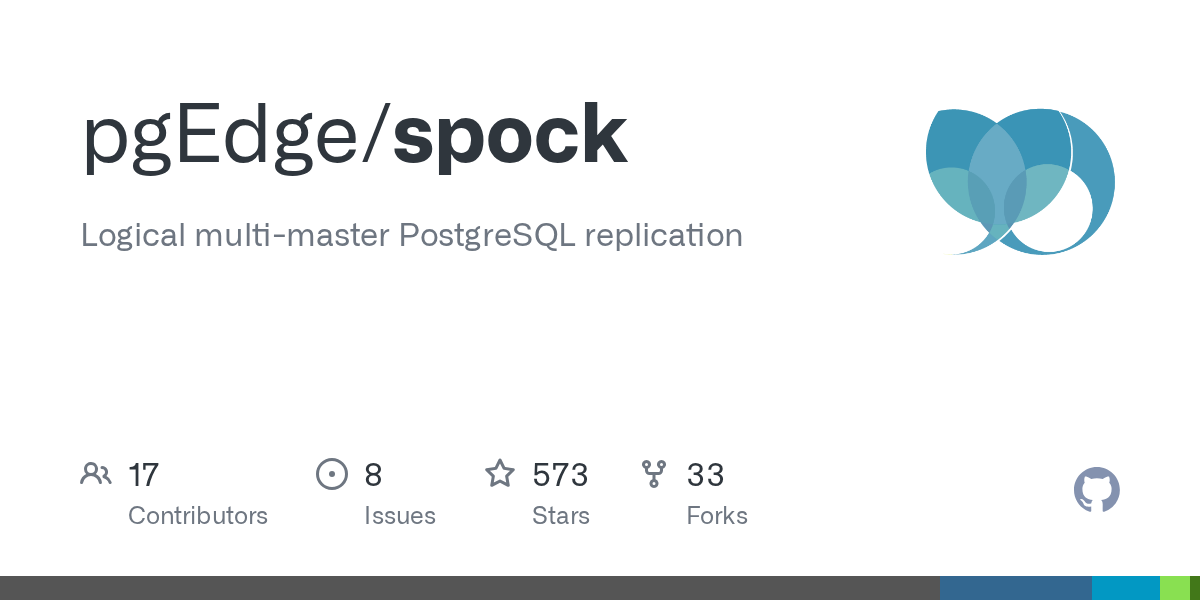Spock Multi-Master Replication for PostgreSQL
Table of Contents
Building the Spock Extension
Building the Spock Documentation
Basic Configuration and Usage
Upgrading a Spock Installation
Advanced Configuration Options
Spock Management Features
Modifying a Cluster
Monitoring your Cluster
Spock Functions
Using spockctrl Management Functions
Release Notes
Limitations
FAQ
Spock Multi-Master Replication for PostgreSQL – Prerequisites and Requirements
The Spock extension provides multi-master replication for PostgreSQL versions 15 and later. Take the following requirements into consideration as you design your cluster:
You will need to install the Spock extension on each node in your cluster. If you’re performing a major version upgrade, the old node can be running a recent version of pgLogical2 before upgrading it to become a Spock node.
On each node in your cluster, tables must have the same name and reside in the same schema. To check the table name and schema name of an existing table, you can connect to the database with psql and use the d meta-command:
SELECT schemaname, tablename FROM pg_tables ORDER BY schemaname, tablename;
For example:
lcdb=# d
List of relations
Schema | Name | Type | Owner
——–+—————-+———-+———-
public | table_a | table | ec2-user
public | table_a_id_seq | sequence | ec2-user
public | table_b | table | ec2-user
public | table_b_id_seq | sequence | ec2-user
public | table_c | table | ec2-user
public | table_c_id_seq | sequence | ec2-user
(6 rows)
Each table must also have the same columns and primary keys, with the same data types in each column. To review detailed information for all tables within a specific schema, connect to the database with psql and use the d schema_name.* command; for example:
lcdb=# d public.*
Table “public.table_a”
Column | Type | Collation | Nullable | Default
————+————————–+———–+———-+——————————
id | bigint | | not null | generated always as identity
name | text | | not null |
qty | integer | | not null |
created_at | timestamp with time zone | | not null | now()
Indexes:
“table_a_pkey” PRIMARY KEY, btree (id)
Sequence “public.table_a_id_seq”
Type | Start | Minimum | Maximum | Increment | Cycles? | Cache
——–+——-+———+———————+———–+———+——-
bigint | 1 | 1 | 9223372036854775807 | 1 | no | 1
Sequence for identity column: public.table_a.id
Index “public.table_a_pkey”
Column | Type | Key? | Definition
——–+——–+——+————
id | bigint | yes | id
primary key, btree, for table “public.table_a”
…
CHECK constraints and NOT NULL constraints must be the same or more permissive on any standby node that acts only as a subscriber.
For more information about the Spock extension’s advanced functionality, visit here.
Building the Spock Extension
You will need to build the Spock extension on a patched PostgreSQL source tree to which you have applied version-specific .diff files from the spock/patches/Postgres-version directory. The high-level steps to build Postgres and the spock extension are:
Get the Postgres source.
Copy the patch files to the base repository; the patches for each Postgres version are in a version-specific subdirectory of the spock repo. Then, apply each patch, use the command:
patch -p1 < path_to_patch/patch_name Note that you must apply the patches in the numerical order designated by their prefixes in the spock repository (for example, pg16-015-patch-name, then pg16-020-patch-name, then pg16-025-patch-name). configure, make, and make install the Postgres server as described in the PostgreSQL documentation. When the build completes, add the location of your pg_config file to your PATH variable: export PATH=path_to_pg_config_file Then, clone the pgedge/spock repository: git clone https://github.com/pgEdge/spock.git Next, make and then make-install spock. Then, update your Postgres postgresql.conf file, setting: shared_preload_libraries = 'spock' track_commit_timestamp = on # needed for conflict resolution Then, connect to the server and use the CREATE EXTENSION command to create the spock extension on each node in the database you wish to replicate: CREATE EXTENSION spock; Building the Spock Documentation The Spock documentation uses MkDocs with the Material theme to generate styled static HTML documentation from Markdown files in the docs directory. To build the documentation, and run a development server for live previewing: Create a Python virtual environment: python3 -m venv spock-docs-venv Activate the virtual environment: source spock-docs-venv/bin/activate Install MkDocs: pip install mkdocs mkdocs-material Run the local MkDocs server for testing: mkdocs serve INFO - Building documentation... INFO - Multirepo plugin importing docs... INFO - Cleaning site directory INFO - Multirepo plugin is cleaning up temp_dir/ INFO - Documentation built in 0.18 seconds INFO - [14:32:14] Watching paths for changes: 'docs', 'mkdocs.yml' INFO - [14:32:14] Serving on http://127.0.0.1:8000/ Basic Configuration and Usage Before configuring a replication cluster, you will need to perform the following steps on each node of the cluster: build Postgres and Spock, and create the Spock extension. initialize identical databases. modify the postgresql.conf file to support logical decoding automatic DDL replication. modify the pg_hba.conf file and any firewalls to ensure you have connectivity between nodes. Configuration Settings Modify the postgresql.conf file, adding: wal_level = 'logical' max_worker_processes = 10 # one per database needed on provider node # one per node needed on subscriber node max_replication_slots = 10 # one per node needed on provider node max_wal_senders = 10 # one per node needed on provider node shared_preload_libraries = 'spock' track_commit_timestamp = on # needed for conflict resolution You'll also want to enable automatic ddl replication on each node; add these GUCs to the postgresql.conf file as well: spock.enable_ddl_replication=on spock.include_ddl_repset=on You also need to configure your pg_hba.conf file to allow connections between your nodes and ensure that firewalls do not block access. Logical replication connections are treated by pg_hba.conf as regular connections to the provider database. After modifying the configuration files, restart the Postgres server; for example: pg_ctl -D /path/to/data_directory restart Configuring Replication First, we'll invoke the spock.node_create command on each node in the cluster. For example, the following command creates a node named n1 that can be accessed via the connection string specified with the dsn variable: SELECT spock.node_create( node_name := 'n1', dsn := 'host=10.0.0.5 port=5432 dbname=acctg' ); Use the following command to create a node named n2: SELECT spock.node_create( node_name := 'n2', dsn := 'host=10.0.0.7 port=5432 dbname=acctg' ); Next, create the subscriptions between the nodes. Since this is multi-master replication, each node acts as both a subscriber and provider. The first command creates a subscription between n1 and n2: SELECT spock.sub_create( subscription_name := 'sub_n1n2', provider_dsn := 'host=10.0.0.7 port=5432 dbname=acctg' ); The command invoked on n1 specifies the subscription name (sub_n1n2) and the connection string for the node it is subscribing to (n2). Next, create a subscription on n2 that connects to n1: SELECT spock.sub_create( subscription_name := 'sub_n2n1', provider_dsn := 'host=10.0.0.5 port=5432 dbname=acctg' ); To start replication, we'll add tables with pgbench; since we enabled automatic ddl replication, we'll add the tables on n1, and they'll automatically propagate to n2: /path to pgbench/pgbench -i -s 10 acctg Then, to confirm replication, you can connect to both n1 and n2 with psql and check for pgbench tables. psql (17.x) Type "help" for help. bench=# dt List of relations Schema | Name | Type | Owner --------+-------------------+-------+--------- public | pgbench_accounts | table | postgres public | pgbench_branches | table | postgres public | pgbench_history | table | postgres public | pgbench_tellers | table | postgres (4 rows) Deploying Spock Clusters in Containers and with Ansible The pgEdge Github sites hosts repositories that contain artifacts that you can use to simplify spock cluster deployment; for more information, visit: Deploying spock with Ansible Deploying spock in a Container Upgrading You cannot roll back an upgrade because of changes to the catalog tables; before starting an upgrade, make sure you have a current backup of your cluster so you can recreate the original cluster if needed. Then, to upgrade the version of spock that you use to manage your replication cluster, you can remove, build, and upgrade the spock extension like you would any other PostgreSQL extension. To review the spock license, visit here.












